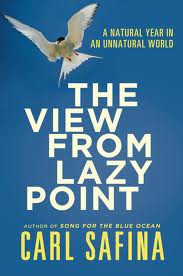
 I adored Song for the Blue Ocean. The first time I read it was a formative moment in my development as a young marine biologist and conservationist. When I picked up Eye of the Albatross and, later, Voyage of the Turtle, I expected that same magic, but could not find it. Safina’s subsequent books were not bad. Both were evocative, beautifully written, and stirring tributes to the natural world. But their stories felt too familiar, like listening to a contemporary symphony built around a Bach fugue or watching a remake of a classic movie. So I approached The View from Lazy Point with the same expectations, as yet another supplement to Song for the Blue Ocean. I was mistaken.
I adored Song for the Blue Ocean. The first time I read it was a formative moment in my development as a young marine biologist and conservationist. When I picked up Eye of the Albatross and, later, Voyage of the Turtle, I expected that same magic, but could not find it. Safina’s subsequent books were not bad. Both were evocative, beautifully written, and stirring tributes to the natural world. But their stories felt too familiar, like listening to a contemporary symphony built around a Bach fugue or watching a remake of a classic movie. So I approached The View from Lazy Point with the same expectations, as yet another supplement to Song for the Blue Ocean. I was mistaken.
The View from Lazy Point is a dramatic departure from Carl Safina’s early work. The book follows one year in Safina’s life, centered around a small house on Long Island. Safina takes us through each month at Lazy Point, tracking the migration of birds and sea life. We join him on beach walks, fishing expeditions, and visits with friends and neighbors, during which he reveals his personal philosophy on the state of our world. His time in Lazy Point is punctuated with trips abroad, exploring the arctic and antarctic, central America, and Pacific islands. On these trips he meets with locals, scientists, and indigenous peoples. Those conversations are filled with compassion and empathy, connecting the reader with those most affected by our changing world.
A few moments in this vast and comprehensive journey have stuck with me days after finishing this book. I am neither jaded nor cynical, but after reading hundreds of books about ocean conservation and environmentalism over the last decade and a half, I am rarely surprised by their content or conclusions. When I encounter an idea that forces me to stop in my tracks and spend a few hours or, in this case, days chewing over a new nugget, I know I’m holding a rare and important addition to the growing body of conservation literature.
Safina describes the stranding and eventual death of a dolphin. Dolphin strandings are not, in themselves, new, and I’ve participated in several. What makes this one different is the way in which it was handled. Long after it was clear to rescue workers that the dolphin could not survive, they kept it alive, not out of compassion or the belief that there was still a chance that it might make it, but because the public was there, and no one wanted to euthanize a marine mammal in front of the public and risk being branded a dolphin killer. The animal was made to suffer needlessly because we weren’t comfortable with the idea of killing it. When the transport vehicle arrive, they loaded the dolphin on, causing more stress, and quietly euthanized it as they drove away. We’ve talked about misplaced outrage in the marine mammal community (see this ancient post on the cult of dolphin worship – Getting a Sense of Porpoise) but never have I seen it laid out so clearly, with such depth and compassion.
Safina’s final adventure, to King George Island to meet with biologists studying penguin colonies, is heartbreaking, not for what it contains, but for what it leaves out. During his stay, Safina describes a day applying flipper tags to five hundred Adélie penguin chicks. His description of the process and the importance of this long term monitoring study is earnest and naïve. As he discusses the decline in penguin populations, attributing it to many effects associated with climate change, I am forced to depart from this captivating narrative and take a moment to reflect upon the grim reality.
It is sad to think that Safina was writing these words perhaps only months or weeks before a study was published in Nature, linking increased penguin mortality and declining health to the very flipper tags that were being applied to these chicks. As my co-blogger discussed before, tagging animals can have very unfortunate consequences. This is part of the process of science. We cannot observe a system without altering it, and we cannot always anticipate negative consequences. This is not a reason to halt scientific research, but rather a reminder that we must constantly evaluate and re-evaluate our methods, replacing those that are found wanting and strive to minimize the damage we cause even as we discover the true extent of human impact upon our world. [UPDATE: Please see Carl Safina’s response in the comments thread and this report from BBC News regarding the penguin declines]
The structure of The View from Lazy Point lends itself to an enduring place in conservation literature. It is a snapshot in time, one year in the history of a world on the verge of rapid and dramatic change. Today it feels familiar, but what will readers a decade away see when they visit Carl Safina’s cabin at Lazy Point?
 Safina, Carl (2011) The View from Lazy Point. Henry Colt and Company, LLC. New York, New York, USA, 401 pgs.
Safina, Carl (2011) The View from Lazy Point. Henry Colt and Company, LLC. New York, New York, USA, 401 pgs.
Saraux C, Le Bohec C, Durant JM, Viblanc VA, Gauthier-Clerc M, Beaune D, Park YH, Yoccoz NG, Stenseth NC, & Le Maho Y (2011). Reliability of flipper-banded penguins as indicators of climate change. Nature, 469 (7329), 203-6 PMID: 21228875
Thanks Andrew for your well-informed review.
Yes i was there before the penguin flipper-band study came out. And, not to defend flipper-banding in light of the findings, I want to point out some nuances. One, we were working with Adelie Penguins, while the study of lowered survival in flipper-banded penguins was done on Kings. It seems possible that that makes a difference, depending on differences in prey speed, commuting and migration distances, and other differences in at-sea ecology among penguin species.
One thing to consider, that might not change the conclusion in the penguin tagging studies I participated in and wrote about, is that the survival of flipper tagged penguin chicks was significantly higher decades ago than now. So, even if survival of tagged chicks is affected compared to un-tagged chicks, there is no apparent reason to suspect that flipper-tags hurt survival less for chicks in the 1980s than now. Because all the chicks in the study I participated in were flipper-tagged, both then and recently, and yet their survival to maturity was higher in the 1980s than now, it seems still valid to conclude that chick survival has in reality declined over the last several decades.
That said, the question of flipper tagging needs to be re-evaluated in light of the king-penguin study. I am not sure why leg rings are not used for penguins. They are not without problems in some cases, but wings (whether flipper-wings or flying wings) are the propelling mechanisms in most birds (ostriches, hide your heads) and a policy of not banding or tagging birds’ wings (wing tags were a problem in birds like hawks) seems highly sensible.
Relatedly, I have leg-banded thousands of birds and have very rarely seen problems from leg bands. A Common Tern I banded survived for another 25 years, a near-record for that species.
Thanks again.
Let me know if your travels take you toward New York or Long Island. No penguins, but lots to see. Actually, penguins too. At several aquariums.
-Carl
And thank you for a wonderful and insightful book. It is comforting to know that there doesn’t appear to be a link between flipper tagging and penguin mortality.
Are non-invasive mark and recaptured studies feasible? I’m thinking specifically of the Montana Grizzly project that proved you could use microsatellite markers amplified from hair and stool samples to identify specific individuals and infer demographic patterns. Something like that seems ideal for penguin colonies where there’s an abundance of feces and discarded feathers. Although expensive, I’m willing to bet that ten years from now the cost of targeted gene sequencing will be less than the value of the metal in a tag.
And I am eagerly awaiting the release of A Sea in Flames!
I was at a luncheon last week where Carl Safina spoke about The View from Lazy Point – both the book and the actual view 🙂 What struck me was his very Zen conviction that compassion is the path to truly sustainable living. It exposed my cynicism: how on Earth (or Ocean) are we going to develop compassionate societies? It’s not exactly something the government can mandate.
two quick comments:
to Andrew: I’m not sure about better bird markers but leg rings are fairly non-invasive. Healthy penguin colonies can be huge so searching for matches among feathers on the ground would seem impractical.
Here is more on Antarctic penguin declines related to declines in krill (their food) due to warming water and melting ice: http://www.bbc.co.uk/news/science-environment-13036795
and to Heather, as I write in the book, ‘To advance compassion and yet survive in a world of appetites—that is our challenge. Where any weakness is crushed or exploited, empathy must be load-bearing. Yet compassion may be the lightest, strongest concept yet devised. Century upon century, it wages a widening peace.
The compass of compassion asks not ”What is good for me?” but “What is good?” Not what is best for me, but what is best. Not what is right for me, but what is right. Not “How much can we take?” but, “How much ought we leave?” and “How much might we give?” Not what is practical but what is moral. With each action we decide whether to sow the grapes of wrath or the seeds of peace.’
The faith and wisdom traditions have these principles in the sacred texts but they’ve been de-emphasized. A refocusing might help leverage the convening power of religions on principles that were designed for sustainability in earlier times, to help reach a very wide audience. That’s expanded on in the book. And to a certain extent, governments can mandate these things. Just look at the health care debate in the US. Where we direct subsidies for fossil or sustainable energy, environmental justice, and assistance to the needy, are other routes. The debate is largely about how much compassion do we want to extend and expend.
Thanks! I’ve added a note in the body of the post pointing readers to your first comment and to the BBC report, for the readers who don’t check out comment threads.
Hello
For those interested, I just published a novel called The Shark and I have based it around the legendary Submarine of False Bay. I saw this shark on three occasions and it dwarfs anything else I have seen and I have seen a few big whites in my life. Its available on Amazon – Kindle.
Thanks
Craig
This comment is probably buried to far down the page for anyone to see. I’m sure if you get in touch with Dave he’d be happy to review it.